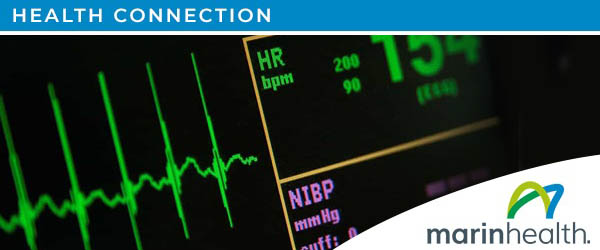Health Connection - Summer 2022

Treating Atrial Fibrillation (AFib): The Most Common Arrhythmia

Having palpitations? Reduced energy? Breathing problems or chest pain? These could be signs of an arrhythmia or abnormal heartbeat. Abnormalities in the heart’s electrical system can cause the heart to beat too slowly, too quickly, or erratically. The most common arrhythmia, atrial fibrillation (AFib) affects 3 to 6 million Americans—almost one in 10 people over the age of 65. Here are some essential facts to help you stay aware of this condition so you can stay healthy and in rhythm.
As your heart beats, the top chambers of the heart, or atria contract and push blood into the bottom chambers or ventricles. In atrial fibrillation, the stimulation of the atrial chambers becomes extremely rapid due to abnormal electrical triggering from the pulmonary veins. As a result, the chambers “quiver” rather than squeeze blood. Clot formation and strokes can result, as well as abnormally fast or uncoordinated heart beats. AFib can occur in brief episodes, frequently, or become a permanent condition. Untreated, atrial fibrillation doubles the risk of heart-related death and increases stroke risk by four to five times.
AFib Symptoms
About one-third of people affected do not have any symptoms and are diagnosed with AFib incidentally. Other people demonstrate any of a number of symptoms, including rapid pounding, or erratic heartbeat, weakness, shortness of breath, extreme fatigue, and in some cases chest pain. Sometimes people feel a sense of just “not feeling right” and can vaguely perceive that their heart rhythm is just not in sync.
Risk Factors for AFib
- Age. Although young people can develop AFib, incidence increases with age.
- High blood pressure
- Obesity
- Diabetes
- Heart failure
- Ischemic heart disease
- Hyperthyroidism
- Chronic stress
- Excessive alcohol intake. (More than 1 drink a day in women and 2 drinks a day in men)
AFib Treatments
The symptoms of AFib are usually treated by restoring the normal heart rhythm and preventing future episodes from being triggered. We call this “rhythm control.” This strategy is usually employed alongside protecting you from stroke.
The treatment that is most appropriate for you will depend on how long you've had atrial fibrillation, the extent of your symptoms, and the underlying cause. It’s best to go through all of the options with your cardiologist or heart rhythm specialist (cardiac electrophysiologist). Below is a brief description of the types of treatments that are often chosen.
Sometimes an initial strategy is to “reset the rhythm” with something called a cardioversion. This usually temporarily restores the rhythm to normal, but does not prevent future episodes of AFib. Therefore, it is usually paired with another strategy to keep the rhythm normal. Sometimes this can be accomplished with medication and lifestyle changes. Another option may be to pursue a procedure called catheter ablation.
Catheter Ablation
Catheter ablationis a procedure performed by an electrophysiologist. This minimally invasive procedure destroys tiny areas of abnormal electrical tissue through freezing (cryoablation) or cauterization/burning/”zapping” (radiofrequency ablation). Catheter ablation is a highly effective and safe procedure. With recent advances in experience and technology, almost all patients have a dramatic reduction in the amount of AFib they have, and some of them are effectively cured. MarinHealth is also at the forefront of clinical trials studying the latest generation of technologies, such as pulsed field ablation, which carries promise for more effective and safe treatment for AFib.
Stroke Risk and Percutaneous Left Atrial Appendage Occlusion
Clots in AFib most often form in a structure called the left atrial appendage, a “blind alley” where blood tends to stagnate. Often, we prescribe blood thinners to reduce the potential for clot formation. Unfortunately, these medications are not a good fit for everyone since they can increase propensity for bleeding. We often seek an alternative, either due to side effects, bleeding, an active lifestyle that increases risks of serious injury, inefficacy, or a patient’s desire to seek an alternative to blood thinners.
We now have access to a highly effective procedure called percutaneous left atrial appendage occlusion. This involves inserting a small device (with an FDA-approved device called the WATCHMAN FLX, often leading to the alternative term “WATCHMAN procedure”). This procedure is percutaneous (minimally invasive), and involves placing this mini umbrella into the left atrial appendage. The procedure is done under general anesthesia and typically takes about an hour. After the procedure, patients usually spend one night in the hospital before being discharged. The WATCHMAN device serves as a scaffold for your body to grow a “skin” over the surface of the device, reducing the potential for embolism from the appendage. Our data shows that most patients can very effectively be protected against stroke, and >95% are able to discontinue their blood thinners after this procedure.
MarinHealth Medical Center was one of the first hospitals in the nation to be granted use of the original WATCHMAN implant, so our team of experts has extensive experience using this innovative treatment. We are one of the Bay Area centers of excellence for this procedure. Learn more about the WATCHMAN procedure and benefits.
We now know that early treatment of AFib prevents progression to more severe or entrenched forms. With any diagnosis of AFib, a cornerstone is to see your cardiologist or cardiac electrophysiologist to discuss treatment options. Learn more about MarinHealth’s Haynes Cardiovascular Institute, our comprehensive, leading-edge Cardiovascular Medicine Program, and the team of experts providing innovative and effective treatment.
Vivek Iyer, MD, MSE is a board-certified cardiac electrophysiologist at MarinHealth Cardiovascular Medicine | A UCSF Health Clinic.
Vaccinating Our Littlest Kids Against COVID-19

There are nearly 20 million children under the age of 5 in the U.S. In mid-June, the news many parents have been eagerly awaiting finally broke: the FDA has granted emergency use authorization (EUA) for COVID-19 vaccines for children ages 6 months - 5 years.
In keeping with the position of the Centers for Disease Control and Prevention (CDC) and the California Department of Public Health, MarinHealth recommends vaccination for children under the age of 5. The many reasons to vaccinate these youngest children include:
- While serious illness is more common in adults than in children, COVID-19 can still make kids sick. Thousands of U.S. children have been hospitalized with COVID-19 and more than 1,000 have died. During the Omicron wave, unvaccinated children ages 5-11 were twice as likely to be hospitalized with COVID-19 than vaccinated children, and 1 in 5 of those who were hospitalized required ICU-level care.
- Children with pre-existing conditions have an elevated risk for severe COVID-19. However, during Omicron, 63% of children under 5 years hospitalized with COVID-19 did not have any underlying conditions.
- COVID-19 can have long-term consequences, including a rare but serious condition called Multisystem Inflammatory Syndrome in Children (MIS-C). This can develop after a COVID-19 infection even if the child had no symptoms. There have been more than 960 cases of MIS-C in California and many of these children ended up in the ICU.
- We are still learning about the ongoing impacts of COVID-19 infection, or “Long COVID.” Some children have experienced ongoing respiratory, cardiac, and neurologic symptoms. Children who have been infected with COVID-19 also have an elevated risk of developing diabetes.
- Very young children are particularly efficient at spreading the virus and can easily pass it on to someone who is elderly, unvaccinated, or immunocompromised. Vaccinating a young child helps protect not only that child, but also their entire household and community.
Frequently Asked Questions
- Are these vaccines safe? What were the trials like?
Yes, the vaccines are safe. In Pfizer's clinical trials, 1,678 children ages 5 and under received three doses and no new safety issues were identified. Moderna's studies included 6,700 children under 6 years old. All received two doses, and no new safety concerns were identified. Across both vaccine trials, there were no cases of myocarditis or pericarditis. - Are these vaccines the same as the adult versions?
Yes, but the doses are much smaller. With Pfizer, adults and those age 12 and up receive two 30-microgram doses. Children under age 5 receive three 3-microgram doses (one-tenth of an adult dose). Children ages 5 to 11 receive two 10-microgram doses. With Moderna, ages 12 and up receive two 100-microgram doses. Children under age 6 get a quarter of that: two 25-microgram doses. Ages 6 to 12 receive two 50-microgram doses. - What is the vaccination schedule for this age group?
The Pfizer vaccine is administered over 11 weeks: two doses are given three weeks apart, then a third dose is given at least two months after the second. The Moderna vaccine is two doses, spaced four to eight weeks apart. - How effective are these vaccines?
Initial results show that the Pfizer vaccine was 80.3% effective in preventing symptomatic infection. The Moderna vaccine was shown to be 51% effective in preventing symptomatic infection for children ages 6 months to 2 years, and 37% effective for children 2 to 5 years. As with adults, the vaccines are very helpful in reducing severe infection. - What are the side effects of the vaccines in the youngest age group?
The side effects are generally milder than in older children. Fussiness, sleepiness, and pain at the injection site may occur. - Will little kids need boosters?
As we’ve seen with adults, it's likely that children under 5 will also need booster doses. Moderna is already testing boosters across all pediatric age groups. - My child recently had COVID-19. Should I still have them vaccinated?
According to the CDC, children can be vaccinated as soon as they feel better and are out of isolation. While the immediate risk of reinfection is low, check with your pediatrician if your child is immunocompromised, or you are traveling to an area with a high infection rate if you are considering delaying vaccination. - Where can I get my child vaccinated?
Details are available on the Marin Health and Human Services website, or talk with your pediatrician’s office.
While the dangers of contracting COVID-19 may seem minimal for young children, vaccinating our youngest kids is ultimately a step toward keeping everyone safer and helping manage the pandemic. With greater vaccine availability, the hope is that the virus will circulate less among children, thereby also reducing transmission back to older people and ultimately reducing the virus’ ability to continue evolving into new variants.
Deciding whether, or when, to vaccinate your child against COVID-19 is an immensely personal decision, but you don’t have to make the choice alone. Whether you are ready to book a vaccine appointment or want to talk through any concerns, start by calling your pediatrician, who is the best resource for your child’s health needs.
Karin Shavelson, MD, FAAP, is the Chief Medical Officer at MarinHealth Medical Center and a board-certified Pediatrician.
Gender Affirmation Surgery: A Life Changing Procedure

Gender is a cornerstone of identity that colors how a person thinks, acts, looks, and expresses themselves. For people whose gender identity is different from the gender they were assigned at birth (gender dysphoria), gender affirmation surgery can be truly liberating and life-altering. In fact, gender affirmation surgery has an extremely high rate of satisfaction, with more than 94% of patients reporting an enhanced quality of life post-surgery.
Gender affirmation surgery is a subspecialty of plastic surgery that requires extensive training. An experienced, empathetic surgeon can help people navigate the challenges that come with the decision to surgically align their bodies with their gender identity. Because gender affirmation surgery is one of the most personal procedures you can have, your surgeon’s approach should be as individualized, collaborative, and understanding as possible.
Far from a cookie cutter operation, gender affirmation surgery is designed to fit the needs and wants of the individual patient. Some patients choose to take hormones before scheduling surgery. Some decide to have surgery on one specific part of their anatomy, such as the chest or face, while others undergo multiple procedures. Timing is also a personal choice. A person may decide to start with a specific procedure or stagger their surgeries over a particular period of time. To determine the right pathway, patients work closely with their doctors to outline an approach based on their goals and health considerations.
MarinHealth’s gender affirmation surgeons have years of experience and excellent results to show for it. We are Board Certified Surgeons with subspecialties and Gender Affirming Surgical training. We spend a great deal of time in consultation with each patient to truly understand their unique situation and experience. We get to know you, ask questions, review photographs, and work hard to create a sense of security and trust. To ensure that all our patients are treated with the respect they deserve, MarinHealth Medical Center provides annual sensitivity training for our entire hospital staff, including RNs, certified nursing assistants (CNAs), technicians, physical and occupational therapists, environmental services workers, and food service staff. Our facility was also ranked as an “LGBTQ+ Healthcare Equality Top Performer” in the Human Rights Campaign Foundation’s Healthcare Equality Index (HEI).
Patients travel from throughout the United States to have gender alignment procedures at MarinHealth Medical Center. A dedicated nurse navigator helps coordinate care during their hospital stay, including setting up in-hospital support such as a therapeutic massage, consultations with our spiritual care or behavioral health teams, or a friendly visit from a therapy dog; and making arrangements for a friend or loved one to stay with them overnight; and planning aftercare. Some of our patients choose to recover locally at the Trans HeartLine House, a safe and affordable post-op recovery home for patients and caregivers.
In order to be a candidate, patients must be physically and emotionally healthy, and must consult with a mental health provider and receive a written diagnosis of gender dysphoria. In addition, people contemplating gender affirmation surgery need to follow the guidelines of the World Professional Association of Transgender Health (WPATH) which require that, in most cases, a person live in their desired gender for at least a year before having surgery.
MarinHealth’s multidisciplinary team provides comprehensive transgender care. We are experienced and equipped to help three categories of patients:
- Transmen seeking masculinizing procedures
- Transwomen seeking feminizing procedures
- Non-binary individuals seeking procedures to make their bodies more congruent with their gender identity
Some of the more common, sought-after procedures we perform include:
- Breast augmentation, the placement of breast implants
- Body contouring, which changes the shape of the body for a more masculine or feminine silhouette—adding or subtracting body fat in the hips and buttocks
- Chest masculinization surgery, a cosmetic mastectomy to create the appearance of a male chest
- Facial feminization, which strives to give the face a more feminine appearance, should be performed by a board-certified surgeon who has trained in either plastic surgery or ear nose and throat surgery, as well as craniofacial surgery or maxillofacial surgery
- Phalloplasty, the creation of a scrotum and penis. This is an exceptionally challenging procedure mastered by a very small number of physicians
- Vaginoplasty, the removal of the penis and testes and creation of a vagina. This procedure necessitates that a person be on feminizing hormones (estrogen and progesterone) for at least a year
Learn more about gender affirmation surgery at MarinHealth, and hear directly from our experts by listening to these short podcasts:
- Facial Gender Affirmation Surgery: A Life-Changing Procedure
- Leading-Edge Surgeries for Trans Men
- New Surgical Options for Trans Women
Dr. Angela Rodriguez is a plastic surgeon specializing in gender affirmation surgery.
Eat the Rainbow!
By Samarra Stephens
Whether you consider yourself a vegetarian, flexitarian, or meat lover, you’ve no doubt heard about the health benefits of plant-based foods. What makes plants so healthy? The magic “ingredient” is polyphenols—micronutrients that naturally occur in plants. Designed to support the plant’s structure and protect the plant, polyphenols can also protect us when we consume them. Many common fruits, vegetables, whole grains, legumes, nuts, seeds, herbs, and spices are filled with polyphenols, which act as antioxidants, helping slow or prevent damage to our cells.
Plant foods can also reduce inflammation, and are loaded with fiber, which helps keep us feeling fuller for longer. Many plant foods, including oats, beans, citrus fruit, apples, carrots, and more, are high in soluble fiber, which can help lower cholesterol, and in turn reduce our risk of developing heart disease. Fiber is also a key player in gut health, which is an important factor in our overall health.
Whether or not you chose to eliminate animal foods, it’s a great idea to increase the number and variety of plant-based foods in your diet. Start by adding just 1-2 more plant foods at each meal and build up from there. Gradually experiment with different spices and herbs such as garlic, cumin, and ginger. You’ll find that your palate will adapt to more flavors and you won’t depend on salt or sugar to get your flavor kick. As an added bonus, eating plant-based foods can help reduce your grocery bill. And don’t worry if your favorites aren’t in season: frozen options are just as nutritious as their fresh counterparts.
One fun way to incorporate more plant-based foods into your diet is to “eat the rainbow,” by choosing plant foods in a variety of colors. Fruits and vegetables get their vibrant colors from pigments, or phytonutrients, and each color indicates the presence of specific nutrients. By incorporating a broad color spectrum of plant foods, you’ll ensure that your body is benefiting from more fiber, vitamins, minerals, polyphenols, and also getting a full range of nutrients.
Some of our favorite plant foods across the rainbow include:
Red
Packed with antioxidants, cherries get their deep red color from their specific polyphenols, called anthocyanins. The deeper the red, purple or blue color, the more anthocyanins the food contains. If you have trouble sleeping, cherries are a great natural way to induce sleep as they promote the production of melatonin, the sleep hormone. Cherries can also help prevent inflammation in muscle tissue, making them a great option if you’re coping with joint aches or soreness after a hard workout.
Orange
The vibrantly orange apricot is easy on the eye in more ways than one. This fruit contains beta-carotene, a pigment of color for orange fruits and the natural source of vitamin A for the body. vitamin A is essential for maintaining eye and skin integrity.
Yellow
Refresh your palate with tangy lemon and get a burst of vitamin C, which can help boost your immunity and is essential for the absorption of iron in the body. Squeeze some fresh lemon juice into a glass of water or tea to keep up your daily dose of vitamin C.
Green
There’s a reason why kale is known as a “superfood.” It’s packed with all kinds of vitamins and minerals our bodies crave and need. Kale is a good source of vitamin K, which helps to promote blood coagulation, and also provides essential calcium, magnesium, and potassium.
Blue
Spirulina, which is gaining attention and popularity due to its many health benefits, is actually a form of blue-green algae. Spirulina boasts a high B-vitamin content that provides you with extra energy, and this cyanobacterium is also an excellent source of vegan protein. Spirulina contains all of the essential amino acids needed by the body, which is rare to find in one plant food.
Purple
Purple cabbage has many health benefits. Eaten fresh, it is a delicious companion to salad greens, and also adds extra fiber to help you maintain a healthy gut. Try it fermented and your gut will also benefit from this cruciferous veggie’s large probiotic content. Either way, antioxidant-rich purple cabbage will keep your digestion healthy and happy.
Brown
Great news – cocoa and coffee have healthy polyphenols as well!
Samarra Stephens is a Nutrition Tech at MarinHealth Medical Center.

